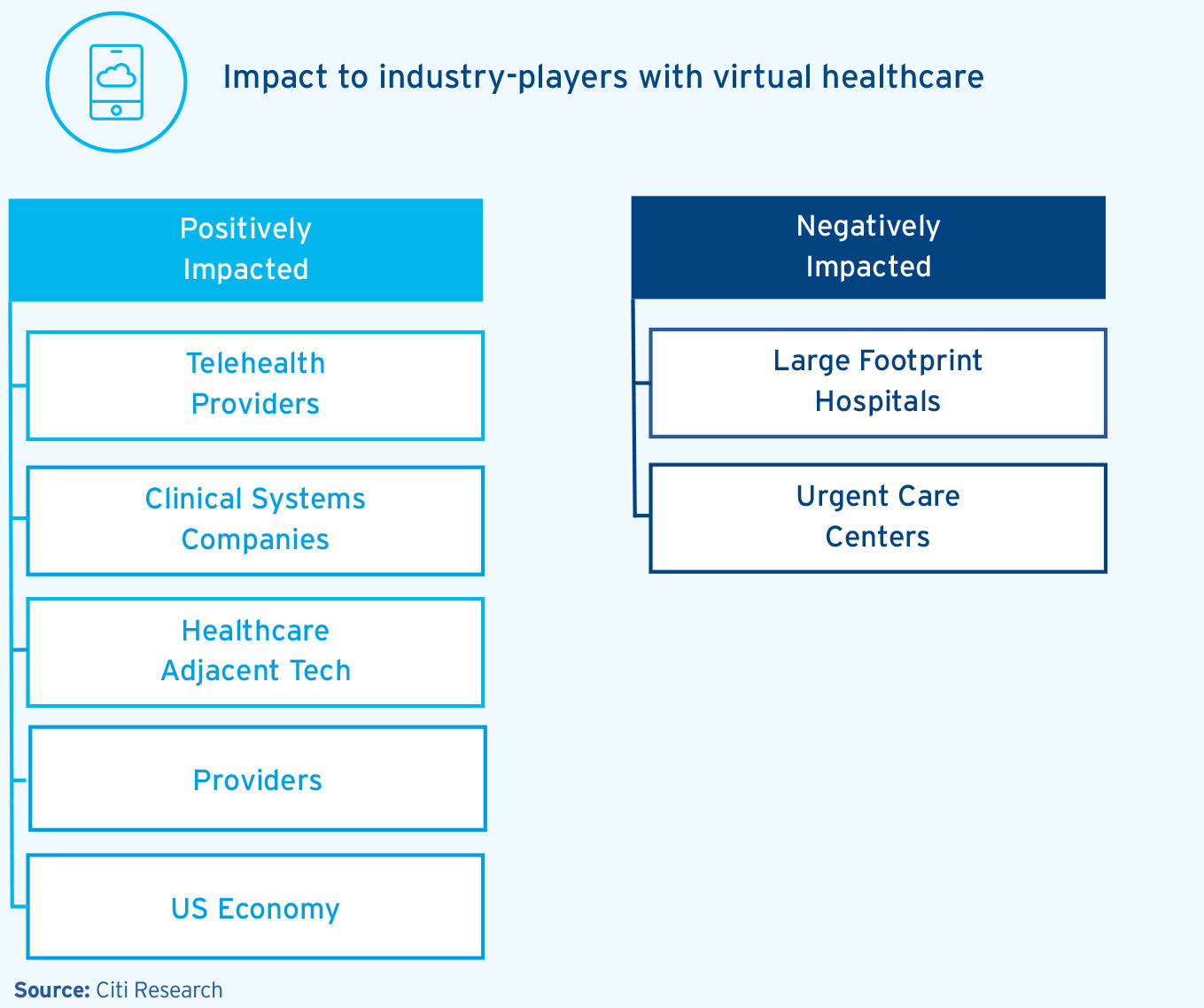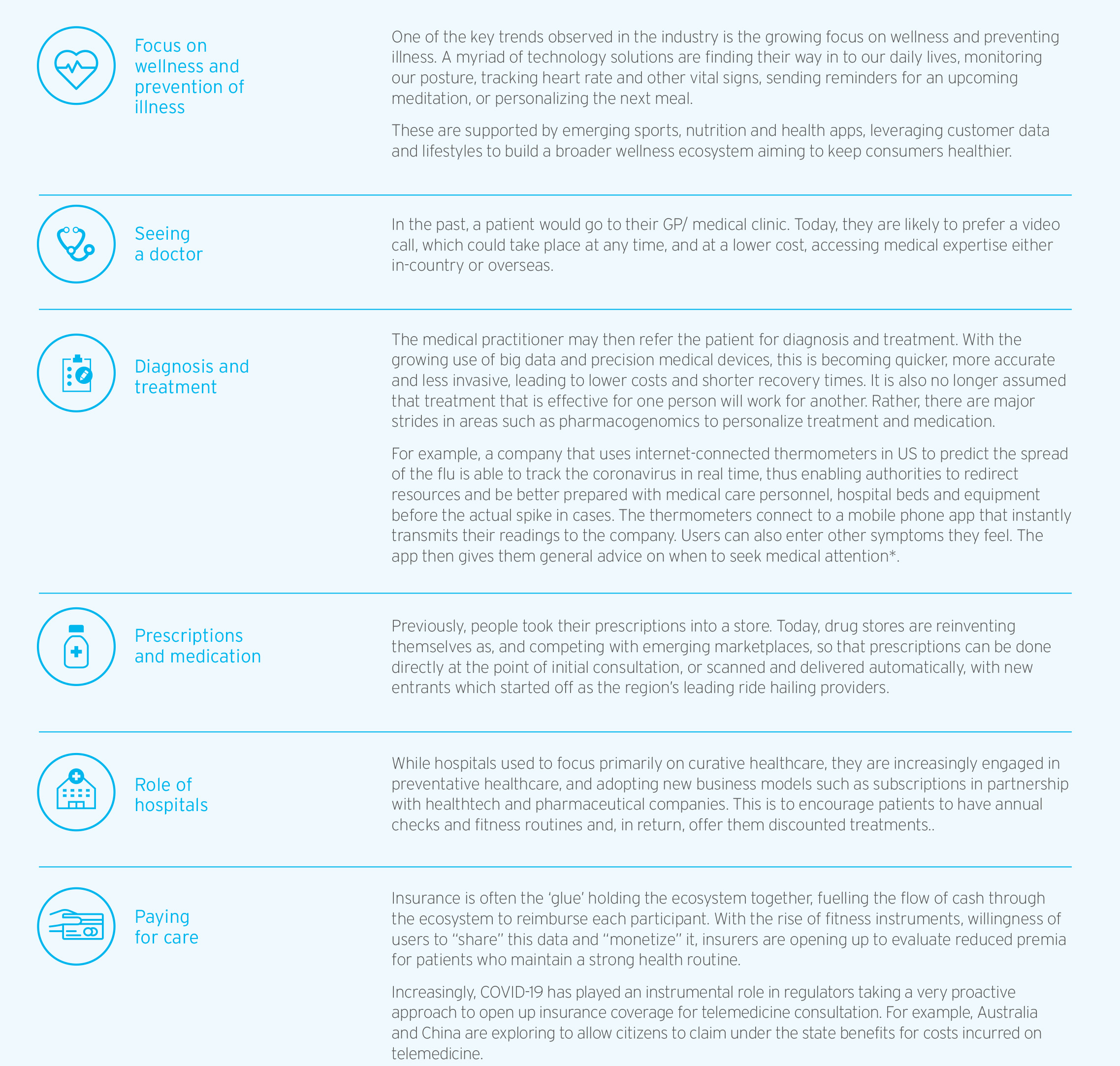Ecosystems: The emergence of value
Virtualizing healthcare
Authors

Parag Bidarkar,
Regional Solution
Sales, Treasury and
Trade Solutions, Citi

Martin Mihov,
Global Subsidiaries Group,
Banking Capital Markets
and Advisory, Citi
Virtual healthcare leveraging digital technology
Digitization in the healthcare sector, and the potential for future development, is a key example of where a horizontal, ecosystem approach to enhance connectivity amongst key players and reduce friction between industry participants can create significant advantage, both for providers and users. Virtual healthcare involves deploying technology via apps, digital data trackers and videos to enabling patients to enjoy quality healthcare and treatment, making time and actual location irrelevant. Virtualization of surgical treatment involves application of robotic surgical tools to transform experience and outcome for all stakeholders – patients, surgeons and hospitals.
With the ongoing disruption caused by COVID-19, the extent of what could be digitized has widened and flexibility of users in adopting the new technologybased models has leap-frogged. What could have essentially taken months and years, has been accepted as normal within weeks. In many ways, the pandemic has accelerated the implementation pace for various universal health programs across Asia markets with wider adoption across Indonesia, India in the last 2 years.
What is also crucial for us to understand here is that every country in Asia Pacific is at a different stage in its journey on healthcare amenities and system for its population. Accordingly, each country is looking to create bespoke approaches to leveraging the newer technologies. For example, whether it is a supply side constraint of relatively lower per capita hospital beds and doctors in Indonesia and India leading to telemedicine as the solution to ride on or higher cost of services leading to challenges in Australia and Singapore with innovative diagnostics being adopted as preventive mechanism to reduce incidents and hence costs. This applies across the public and private sectors with a push to deploy technologies in a practical manner, which enables faster, safer and resilient service to consumers.
At the same time, the industry is shifting towards more personalized digital healthcare and fields such as insurance, healthcare providers and medical equipment are becoming important ecosystem participants. These include not only ‘traditional’ medical, pharmaceutical and medical equipment companies, but new players too. For example, a major pharma corporation is connecting with oncology centers in the US and using anonymized patient data to evaluate newer lines of treatment for future patients - combining genomic and clinical data to understand what drives the disease and how it develops. Multiple pharma companies are focusing on building a wide and representative anonymized clinical data to understand trends and impact of medicines better. A large ASEAN based logistics service provider, is competing with traditional and online drugstores by leveraging their transport network to offer an integrated experience of ordering-todelivery. Chinese consumer giants are also investing in app-based healthcare diagnostics with an ability to conduct video consulting on-demand with doctors and then also leveraging strength in logistics to deliver medicines to patients – so patients do not have to leave their residence at all!
Given the ongoing turbulence, focus on safety, continued need for social distancing, adoption of these services has been rapid – from private sector in Asia to government-run healthcare programs across Asia.
Drivers for digitization and virtualization of healthcare
Sustainable future driven healthcare
As with all other aspects of our society and economy, a view towards a more sustainable and future-driven healthcare requires a hard look on how we practise healthcare – especially when how we deliver healthcare has not changed for decades. We believe this will be driven by a combination of factors:
- from demand side arising out of
- rising healthcare costs;
- changing population patterns and;
- proliferation of high-speed internet,
- smartphones in the age of ‘instant gratification’ to;
- supply side caused by
- a shortage and inequitable distributed healthcare resources;
- favorable regulatory environment;
- improved insurance coverage with national insurance coverage picking up in large Asian countries.
Change of demographic patterns: Twin impact of increased ageing population and more millennials in population seeking healthcare
- Ageing population: With the number of people over 60 outnumbering youngsters by 2050 globally, the demand-supply dynamics will get massively impacted - as a higher prevalence of chronic diseases among senior citizens, will create a far greater demand for healthcare services. It dictates the necessity to redesign the global healthcare system for this new paradigm – to deliver a more efficient care experience at a lower cost by deploying the right digital technology. Virtual healthcare solutions delivered remotely have the potential to allow seniors to secure treatment and care at home instead of the more expensive higher acuity care at hospitals and most importantly also not disrupt their usual daily life as much. It allows the same number of doctors to cover more patients.
- Millennials: An increasing number of millennials will seek healthcare attention now and in future. This is a generation which grew up in the age of “Instant Gratification” riding on online shopping experiences with same-day shipping and digital banking. With their focus on convenience, flexibility and reduced friction in all forms (waiting times, payment modes and travel), a natural tilt towards virtual healthcare is highly likely
Sheer shortage and unequally distribution of resources: Doctors, nursing staff and large hospital centers vs actual needed levels and locations.
- As demand increased with increased improved insurance coverages (public national insurances in multiple markets in Asia – Indonesia, India and now planned for Philippines) - and aging population requires more frequent and longer tenor care, the demand-supply situation will be unfavourably altered.
- Today’s physical infrastructure across developing markets in Asia is concentrated in bigger cities resulting in a large portion of rural/remote population struggling to access it in a timely fashion.

A digital consumer experience via virtual delivery of healthcare
Digitization and connectivity across ecosystems are key enablers for new market entrants, with new business models having a transformative effect on the healthcare industry, and the experience of consumers. We see the below model developing:

However, there are a number of barriers and points of friction within the healthcare ecosystem. Every participant in the healthcare ecosystem needs to be paid, often before the next step in a patient’s healthcare journey can be taken. For example, a drugstore needs to be paid for a prescription before a person receives medication. Hospitals may not be able to perform lifechanging treatments until insurance approval has been obtained. The faster that payments can be made across the ecosystem, the more responsive, and better quality a service that patients receive.
Leveraging solutions and expertise
Financial Institutions play a major role in facilitating dynamic healthcare ecosystems, and Citi is pioneering an integrated healthcare ecosystem model to work with clients in China, India and Indonesia, engaging customers to deliver value, through solutions and services for seamless healthcare outcomes. The healthcare industry is highly capital-intensive, while access to working capital is essential to create resilience and flexibility across ecosystems. Consequently, healthcare ecosystem participants benefit significantly from Citi’s comprehensive capital markets, supply chain finance and global liquidity management solutions. Citi is working with many fintech partners to provide a bespoke solution for the specific needs of each participants. For example, hospitals and clinics require quicker insurance pay-outs whilst minimizing the overhead costs of raising claims. Insurance companies themselves, require comprehensive data and all underlying details to assess each claim. Citi pioneered a bespoke cards based payments model in Indonesia leveraging its relationship with both hospitals and insurance providers. Participants in the overall ecosystem need universal banking services, with real-time transactions supported with rich data. By embracing these services, companies can accelerate and automate the exchange of flows, and allow automatic reconciliation and posting of cash flows to trigger the next step in the healthcare lifecycle, such as treatment or medication without delay.
Patient experience is key for these new-age platforms and Citi is in a strong position to help provide an omni-channel payments suite for collecting through a host of options: QR Code, instant payments, instant FX and upcoming Spring by Citi payment gateway for enabling the flow seamlessly. Coupled with our ready to plug-in Application Program Interface (API) stack, the ecosystem participants can benefit from an instant flow of information and updates
Choosing the right banking partner is essential to create, sustain and exchange value across healthcare ecosystems. Banks need to take a 360-degree view of ecosystems, focusing on connectivity between ecosystem counterparts, and addressing the points of friction.
Many companies entering the industry for the first time are fastgrowing companies with expertise in enhancing the client experience, but with less experience in dealing with the regulatory, ethical and confidentiality implications. Likewise, traditional healthcare providers have significant expertise in the complexities of clinical and patient data, regulatory compliance and project funding, but less insight into direct-to-consumer business models and importance of a seamless customer experience.
Consequently, the right banking partner that can offer the depth and breadth of experience within and across markets and combine it with actual on-ground industry knowledge is essential.
*https://www.nytimes.com/2020/03/18/health/coronavirus-fever-thermometers.html